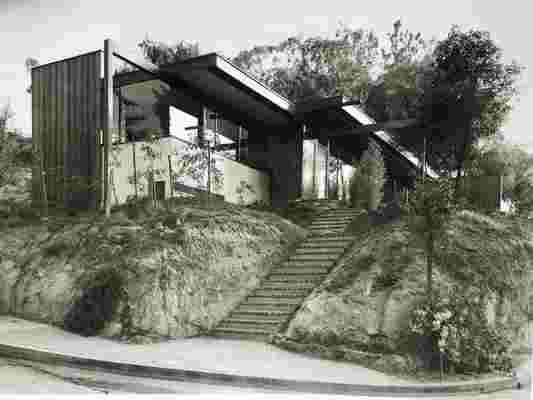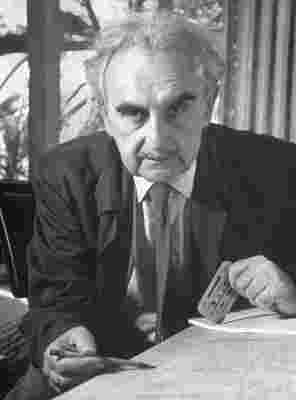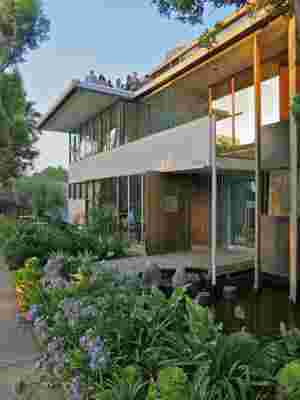When it came to defining the architectural style of California during the mid–20th century, perhaps no one played a bigger role than Richard Neutra. The Austrian-born architect was responsible for some of the era’s most recognizable homes, from the Kaufmann House in Palm Springs, which was immortalized by photographer Slim Aarons, to the Lovell Health House.
While Neutra’s airy steel and glass structures defined the times, his ideas were ahead of them. In 1953, the architect published Survival Through Design, a book of 47 essays exploring the impact of the built environment on physical and mental health. In a review in The New York Times, Talbot Hamlin wrote, “It reminds us that all the things we find dangerous and even intolerable in our environment today (and this includes the atomic bomb) are the results of human design working under an economic system that sets a premium in artificial obsolescence and that these things are susceptible of human amelioration and cure. Every architect and industrial designer, every policy-making executive in industry should read and ponder this elegant warning.”

Reunion House was built by Neutra in 1950 to accommodate visiting children and grandchildren. Dion Neutra added a studio apartment to the complex in the 1980s and lived in the main house until his death last year.
Neutra was extremely concerned by the consequences of design. “Conceivably far-reaching influences on the future of a species can be exerted through design,” he wrote in the book. “Out of ignorance, we permit our instrument, human design, to operate accidentally, and it may bring about mutations more faithful than nature’s.” To help combat this ignorance, he founded the Neutra Institute for Survival Through Design in 1962 in hopes of increasing the amount of research on the topic. “He was thinking that his reputation could attract donations,” says Raymond Neutra, a physician and a son of the architect. “If they could support research, they could help people who are affected by the environment.” Unfortunately, the funds and the research didn’t materialize. Following Neutra’s death in 1970, his son Dion, who was also an architect working at the family firm, took over as president and chief consultant.
A few years ago, the Neutra Institute’s board began thinking of the future mission of the organization and how they can accomplish the original goals set forth by the architect. Dion died in November 2019, leaving the Institute a sizable bequest of stocks and bonds and three Neutra-designed buildings in the Silver Lake area of Los Angeles. Now Raymond has stepped into the role of president of the Institute and is hoping to realize the new set of five-year goals he developed with his brother and the board.

Architect Richard Neutra, pictured here working on his drawing board, died 50 years ago today.
Supporting research is still a top priority, and while Raymond Neutra notes that it is still in the beginning stages of planning, the Institute could potentially fund publications, visiting fellowships, and workshops. With Neutra archives located at UCLA; California Polytechnic State University, Pomona; and Cornell, the board plans to create comprehensive catalogs and finding aids to help remove barriers to scholarly research and develop a website linking Neutra information from around the world.
The organization will also work to restore the three buildings, which include the Reunion House, designed by Neutra in 1950 and later renovated by Dion; Treetops, an apartment complex designed by Dion; and the Neutra Museum. “One of the goals is to make educational use of those buildings,” says Raymond. “We’re focusing on the fact that all of them have apartments that relate to the surrounding nature. We’re going to focus on the basic needs of apartment living—how they are satisfied by these designs, but also what are the basic needs and how will they be accommodated for a changing climate.”

Neutra VDL Studio and Residences was the home of Richard Neutra, who originally designed it in 1932. It was destroyed by a fire in 1963, and Dion rebuilt the home with his father. Neutra’s wife, Dione, donated it to California Polytechnic State University, Pomona, in 1990.
The institute also hopes to designate the Neutra Colony, which includes the three Silver Lake buildings and the nearby Neutra VDL Studio and Residences, as a historic district and create augmented-reality virtual tours of the spaces in the colony.
The ultimate resource for design industry professionals, brought to you by the editors of Architectural Digest
“It's an interesting end-of-life project,” says Raymond. “I’m 81 years old and my own career was in environmental public health. So there’s a relation, not surprisingly, between where I grew up and what I ended up doing. It’s a nice opportunity for the family and other interested people to work together to create something constructive around this issue of a helpful and healthful environment.”
